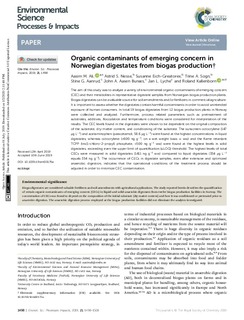| dc.contributor.author | Ali, Aasim Musa Mohamed | |
| dc.contributor.author | Nesse, Astrid Solvåg | |
| dc.contributor.author | Eich-Greatorex, Susanne | |
| dc.contributor.author | Sogn, Trine Aulstad | |
| dc.contributor.author | Aanrud, Stine Göransson | |
| dc.contributor.author | Bunæs, John Ansgar Aasen | |
| dc.contributor.author | Lyche, Jan Ludvig | |
| dc.contributor.author | Kallenborn, Roland | |
| dc.date.accessioned | 2020-01-03T11:10:53Z | |
| dc.date.available | 2020-01-03T11:10:53Z | |
| dc.date.created | 2019-06-10T21:52:07Z | |
| dc.date.issued | 2019 | |
| dc.identifier.citation | Environmental Science: Processes & Impacts. 2019, 21 (9), 1498-1508. | nb_NO |
| dc.identifier.issn | 2050-7887 | |
| dc.identifier.uri | http://hdl.handle.net/11250/2634760 | |
| dc.description.abstract | The aim of this study was to analyze a variety of environmental organic contaminants of emerging concern (CEC) and their metabolites in representative digestate samples from Norwegian biogas production plants. Biogas digestates can be a valuable source for soil amendments and/or fertilizers in commercial agricultural. It is important to assess whether the digestates contain harmful chemicals in order to avoid unintended exposure of human consumers. In total 19 biogas digestates from 12 biogas production plants in Norway were collected and analyzed. Furthermore, process related parameters such as pretreatment of substrates, additives, flocculation and temperature conditions were considered for interpretation of the results. The CEC levels found in the digestates were shown to be dependent on the original composition of the substrate, dry-matter content, and conditioning of the substrate. The sunscreen octocrylene (147 µg/L) and acetaminophen (paracetamol; 58.6 µg/L) were found at the highest concentrations in liquid digestates whereas octocrylene (> 600 ng/g, on a wet weight basis = ww ) and the flame retardant TCPP (tris (1-chloro-2-propyl >500 ng/g ww) were found at the highest levels in solid digestates, exceeding even the upper method limit of quantification threshold (uLOQ). The highest levels of total CECs were measured in solid digestates (1411 ng/g ww) compared to liquid digestates (354 µg/L equals 354 ng/g). The occurrence of CECs in digestate samples, even after extensive and optimized anaerobic digestion, indicate that the operational conditions of the treatment process should be adjusted in order to minimize CEC contamination. | nb_NO |
| dc.language.iso | eng | nb_NO |
| dc.relation.uri | https://pubs.rsc.org/en/content/articlehtml/2019/EM/C9EM00175A | |
| dc.rights | Attribution-NonCommercial-NoDerivatives 4.0 Internasjonal | * |
| dc.rights.uri | http://creativecommons.org/licenses/by-nc-nd/4.0/deed.no | * |
| dc.title | Organic contaminants of emerging concern in Norwegian digestates from biogas production | nb_NO |
| dc.type | Journal article | nb_NO |
| dc.type | Peer reviewed | nb_NO |
| dc.description.version | publishedVersion | nb_NO |
| dc.source.pagenumber | 1498-1508 | nb_NO |
| dc.source.volume | 21 | nb_NO |
| dc.source.journal | Environmental Science: Processes & Impacts | nb_NO |
| dc.source.issue | 9 | nb_NO |
| dc.identifier.doi | 10.1039/c9em00175a | |
| dc.identifier.cristin | 1703783 | |
| dc.relation.project | Norges forskningsråd: 268214/E50 | nb_NO |
| cristin.unitcode | 192,12,0,0 | |
| cristin.unitcode | 192,14,0,0 | |
| cristin.unitcode | 192,16,2,0 | |
| cristin.unitname | Kjemi, bioteknologi og matvitenskap | |
| cristin.unitname | Miljøvitenskap og naturforvaltning | |
| cristin.unitname | Institutt for mattrygghet og infeksjonsbiologi | |
| cristin.ispublished | true | |
| cristin.fulltext | original | |
| cristin.qualitycode | 1 | |

